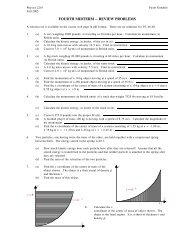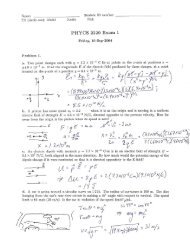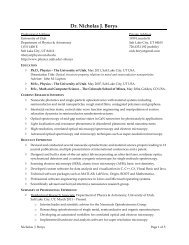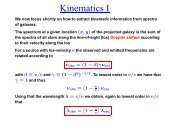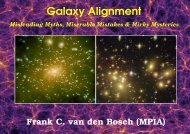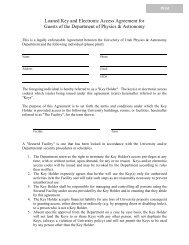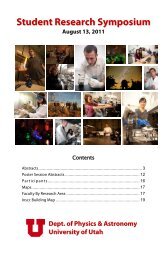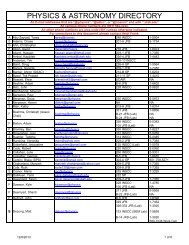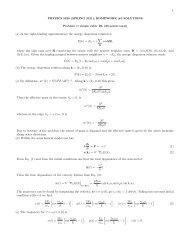You also want an ePaper? Increase the reach of your titles
YUMPU automatically turns print PDFs into web optimized ePapers that Google loves.
Discussion Problems for the week of Feb 18, 2013<br />
Part 1 (exam 3 prep for Ch. 20 and 21)<br />
1. A resistor is connected across the terminals of a 9.0-V battery, which delivers 1.1 × 10 5 J of<br />
energy to the resistor in six hours. What is the resistance of the resistor?<br />
16 Ω<br />
2. Tungsten has a temperature coefficient of resistivity of 0.0045 (C°) -1 . A tungsten wire is<br />
connected to a source of constant voltage via a switch. At the instant the switch is closed, the<br />
temperature of the wire is 28 °C, and the initial power delivered to the wire is P 0 . At what wire<br />
temperature will the power that is delivered to the wire be decreased to ½P 0 ?<br />
250° C<br />
3. To save on heating costs, the owner of a greenhouse keeps 660 kg of water around in barrels.<br />
During a winter day, the water is heated by the sun to 10.0 °C. During the night the water freezes into<br />
ice at 0.0 °C in nine hours. What is the minimum ampere rating of an electric heating system (240 V)<br />
that would provide the same heating effect as the water does?<br />
32 A<br />
4. The current in the 8.00-Ω resistor in the drawing is 0.500 A. Find<br />
the current in<br />
(a) the 20.0-Ω resistor and in<br />
(b) the 9.00-Ω resistor.<br />
(a) 0.750 A<br />
(b) 2.11 A<br />
5. Determine the voltage across the 5.0-Ω resistor in the<br />
drawing. Which end of the resistor is at the higher potential?<br />
0.75 V. Left end is at higher potential.
6. Four identical capacitors are<br />
connected with a resistor in two different<br />
ways. When they are connected as in part a of<br />
the drawing, the time constant to charge up<br />
this circuit is 0.72 s. What is the time constant<br />
when they are connected with the same<br />
resistor, as in part b?<br />
0.29 s<br />
7. In the model of the hydrogen atom created by Niels Bohr, the electron moves around the<br />
proton at a speed of 2.2 × 10 6 m/s in a circle of radius 5.3 × 10 -11 m. Considering the orbiting electron to<br />
be a small current loop, determine the magnetic moment associated with this motion. (Hint: The<br />
electron travels around the circle in a time equal to the period of the motion.)<br />
9.3 × 10 -24 A · m 2<br />
8. The magnetic field produced by the solenoid in a magnetic resonance imaging (MRI) system<br />
designed for measurements on whole human bodies has a field strength of 7.0 T, and the current in the<br />
solenoid is 2.0 × 10 2 A. What is the number of turns per meter of length of the solenoid? Note that the<br />
solenoid used to produce the magnetic field in this type of system has a length that is not very long<br />
compared to its diameter. Because of this and other design considerations, your answer will be only an<br />
approximation.<br />
2.8 × 10 4 turns/m<br />
Part 2 more on Ch 21.<br />
9. The drawing shows a thin, uniform rod that has a length of<br />
0.45 m and a mass of 0.094 kg. This rod lies in the plane of the<br />
paper and is attached to the floor by a hinge at point P. A uniform<br />
magnetic field of 0.36 T is directed perpendicularly into the plane<br />
of the paper. There is a current I = 4.1 A in the rod, which does not<br />
rotate clockwise or counterclockwise. Find the angle θ. (Hint: The<br />
magnetic force may be taken to act at the center of gravity.)<br />
44°
10. The coil in the Figure contains 410 turns and has an area per turn<br />
of 3.1 × 10 -3 m 2 . The magnetic field is 0.23 T, and the current in the coil is<br />
0.26 A. A brake shoe is pressed perpendicularly against the shaft to keep<br />
the coil from turning. The coefficient of static friction between the shaft<br />
and the brake shoe is 0.76. The radius of the shaft is 0.012 m. What is the<br />
magnitude of the minimum normal force that the brake shoe exerts on<br />
the shaft?<br />
8.3 N<br />
11. A square coil of wire containing a single turn is placed in a uniform 0.25-T<br />
magnetic field, as the drawing shows. Each side has a length of 0.32 m, and the<br />
current in the coil is 12 A. Determine the magnitude of the magnetic force on each<br />
of the four sides<br />
0.96 N for the top and bottom sides, 0 for the other two.<br />
12. T he two conducting rails in the drawing are tilted<br />
upward so they each make an angle of 30.0° with respect to<br />
the ground. The vertical magnetic field has a magnitude of<br />
0.050 T. The 0.20-kg aluminum rod (length = 1.6 m)<br />
slides without friction down the rails at a constant velocity.<br />
How much current flows through the rod?<br />
14 A<br />
13. A long, cylindrical conductor is solid throughout and has a radius R. Electric charges flow<br />
parallel to the axis of the cylinder and pass uniformly through the entire cross section. The<br />
arrangement is, in effect, a solid tube of current I 0 . The current per unit cross-sectional area (i.e., the<br />
current density)<br />
is I 0 /(πR 2 ). Use Ampère's law to show that the magnetic field inside the conductor at a distance r from<br />
the axis is μ 0 I 0 r/(2πR 2 ). (Hint: For a closed path, use a circle of radius r perpendicular to and centered on<br />
the axis. Note that the current through any surface is the area of the surface times the current density.)<br />
The answer is a proof.



